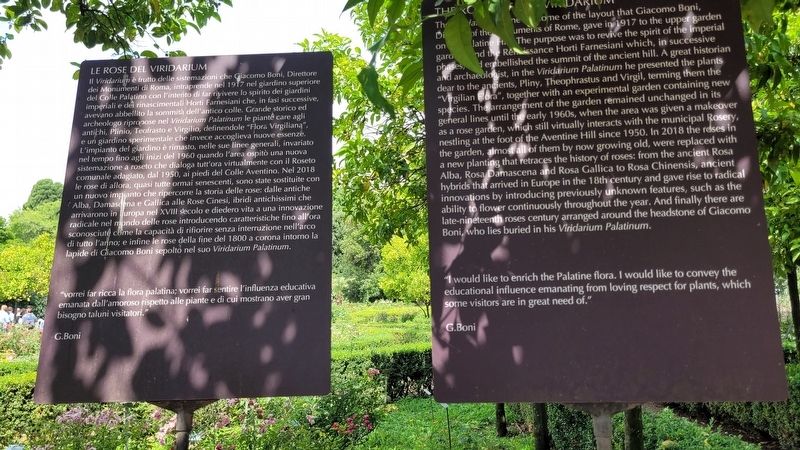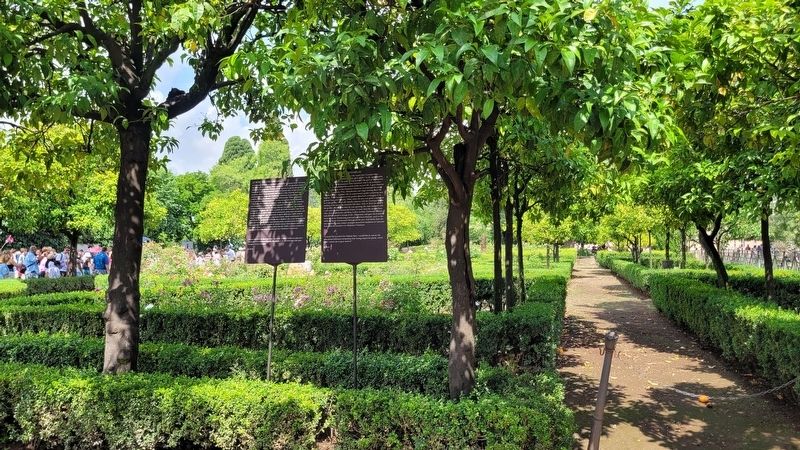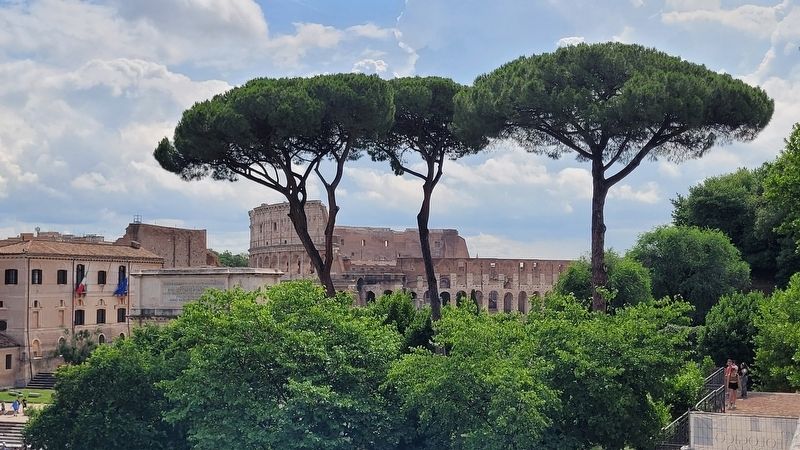Rione X Campitelli in Roma in Città metropolitana di Roma Capitale, Latium, Rome, Italy — Central Italy (Tyrrhenian Coast)
Le Rose del Viridarium / The Roses of the Viridarium
Inscription.
"vorrei far ricca la flora palatina; vorrei far sentire l'influenza educativa emanata dall'amoroso rispetto alle piante e di cui mostrano aver gran bisogno taluni visitatori."
G.Boni
The Viridarium is the result of the layout that Giacomo Boni, Director of the Monuments of Rome, gave in 1917 in the upper garden of the Palatine Hill. The purpose was to revive the spirit of the imperial garden and the Renaissance Horti Farnesiani which, in successive phases, and embellished the summit of the ancient hill. A great historian and archaeologist, in the Viridarium Palatinum he presented the plants dear to the ancients, Pliny, Theophrastus and Virgil, terming them the "Virgilian Flora", together with an experimental garden containing new species. The arrangement of the garden remained unchanged in its general lines until the early 1960s, when the area was given a makeover as a rose garden, which still virtually interacts with the municipal Rosery, nestling at the foot of the Aventine Hill since 1950. In 2018 the roses in the garden, almost all of them by now
growing old, were replaced with a new planting that retraces the history of roses: from the ancient Rosa Alba, Rosa Damascena and Rosa Gallica to Rosa Chinensis, ancient hybrids that arrived in Europe in the 18th century and gave rise to radical innovations by introducing previously unknown features, such as the ability to flower continuously throughout the year. And finally there are late-nineteenth roses century arranged around the headstone of Giacomo Boni, who lies buried in his Viridarium Palatinum.
"I would like to enrich the Palatine flora. I would like to convey the educational influence emanating from loving respect for plants, which some visitors are in great need of."
G.Boni
Topics. This historical marker is listed in these topic lists: Agriculture • Anthropology & Archaeology. A significant historical year for this entry is 1917.
Location. 41° 53.423′ N, 12° 29.22′ E. Marker is in Roma, Lazio (Latium, Rome), in Città metropolitana di Roma Capitale. It is in Rione X Campitelli. Marker is at the intersection of Via Sacra and Via Nova on Via Sacra. The marker is located west of the Arch of Titus in the Roman Forum. Touch for map. Marker is in this post office area: Roma, Lazio 00186, Italy. Touch for directions.
Other nearby markers. At least 8 other markers are within walking distance of this marker. I giardini del XIX secolo / The gardens of the 19th century (a few steps from this marker); Giacomo Boni sul Palatino / Giacomo Boni on the Palatine (a few steps from this marker); Uccelliere / Aviary (a few steps from this marker); Le ragioni dell'archeologia / The development of archaeology (a few steps from this marker); Teatro del Fontanone / Fountain Theater (a few steps from this marker); I colori dell'abitare / The colours of dwelling (a few steps from this marker); Le case aristocratiche del Palatino / The Aristocratic Houses of the Palatine Hill (within shouting distance of this marker); Dal collezionismo all'archeologia / From collecting to archaeology (within shouting distance of this marker). Touch for a list and map of all markers in Roma.
More about this marker. The marker is located in the Parco Archeologico del Colosseo (Roman Forum Archaeological Park) and it does require an entry fee to visit.
Also see . . .
1. Parco Archeologico del Colosseo. Roma Turismo (Submitted on August 5, 2023, by James Hulse of Medina, Texas.)
2. Giacomo Boni (archaeologist). Wikipedia (Submitted on August 6, 2023, by James Hulse of Medina, Texas.)
Credits. This page was last revised on August 6, 2023. It was originally submitted on August 5, 2023, by James Hulse of Medina, Texas. This page has been viewed 86 times since then and 36 times this year. Photos: 1, 2, 3. submitted on August 6, 2023, by James Hulse of Medina, Texas.


